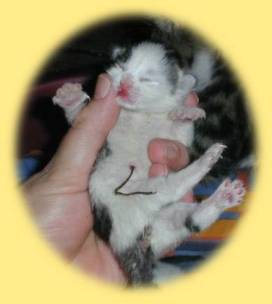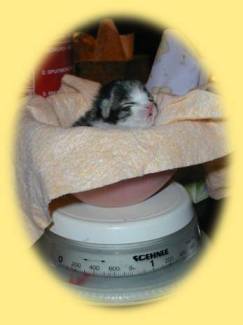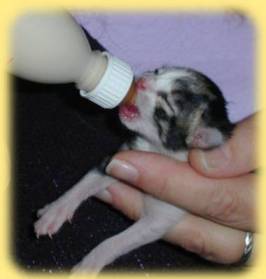|
|
 |
| When her time has come, the cat
will get labour pains and contractions. Stay with her, be very quiet, with
well-washed and disinfected hands. After a while a membrane shows, with
the head visible in it (sometimes the tail shows first: breech birth).
After a few contractions a kitten comes out still wrapped in a membrane. See to it that the mother stays in the box. Sometimes the membrane has not broken, and if the kitten inside doesn't move the mother may sometimes ignore it although it may still be alive. In that case open the membrane quickly and get the kitten out. Usually from then on mommy will take over. She then starts to wash and lick the kitten dry. This will also stimulate it's breathing. Only intervene if the mother doesn't do anything at all with the kitten. She will also bite through the umbilical cord. If she doesn't do this, you may help her by squeezing with your sharp nails, and thus cutting through the umbilical cord, about 3 centimeters away from the kitten's abdomen. Do not pull because this will cause a navel rupture. Best is to place a clamp on the umbilical cord, and then cut the cord between the clamp and the abdomen with a sharp disinfected pair of scissors. Disinfect the scissors as follows: first wash your hands, and then disinfect the scissors with 70% alcohol or Betadine iodine 10%. The disinfecting should be done at the very last minute or it will be useless. The mother will eath the afterbirth; this is very important for her nourishment and lactation. Once the mother quiets down, the kitten will probably crawl towards the nipple. The very first milk is very important for the kitten (colostrum). If the contractions continue without a kitten being born, don't wait too long (no longer than an hour) before contacting a vet. With every birth an afterbirth should come out: count them !!!! If it doesn't they should come in a later stage of the delivery. If they don't come out a few hours after delivery, also contact a veterinarian. In short: when in doubt about the well-being of mother or kittens, allways have a vet come over immediately.!
Do not try to remove the leftover umbilical cord: it falls off all by itself. The first days after the delivery
the mother will have a little discharge. Pay attention that this discharge
doesn't start to smell foul. If that's the case: please contact your vet.
And please pay close attention to
this: a female cat can go into heat and get pregnant again immediately
after delivery while still nursing her kittens !!
Kittens must gain weight at least
10 grams per day. Buy scales that can weigh very accurately each
gram. Write down the birth weights in a notebook, and enter also color
and gender of each kitten. For the next few weeks keep making notes.
After about 10 days the eyes will
open. Keep checking the weights. If the litter has many kittens, you may
have to supplement the mother's feeding. There are excellent Kitten Milk
Replacers like Lactol, KMR or Litterlac (ask your vet or buy online). You
also need little bottles with a nipple in case the mother has no
(more) milk or doesn't want to nurse. If a kitten doesn't gain enough weight
and you have to supplement food, add some dissolved dextrose to the kittenmilk.
After about 4 to 5 weeks you can start supplementing with solid food. Best is Nutrix rice pudding mixed with kittenmilk. Warning: never give Brinta (wheat product) which has too much fiber and can cause diarrhea. Give only easily digestible porridge like Nutrix, mixed with Litterlac, KMR or Lactol. As soon as they can eat that, after
a week you can slowly add a tiny amount of canned kittenfood in the rice
pudding. Do this very carefully!! Every few days add a little more canned
food, until there's only that to eat and no more rice pudding. At the age
of 6 weeks you can start mixing a bit of soaked kittenkibble with the canned
kittenfood. Slowly add more kibble with less canned food and at 12 weeks
kittens almost allways will also eat kibble.
|
|||||
| © M.A.
de Boer 2003-2004. All rights reserved.
Nothing may be copied in any form without permission of the author who can be contacted via the email-link above. |


